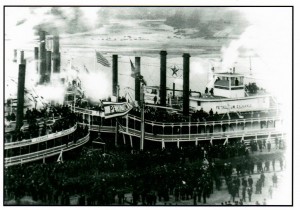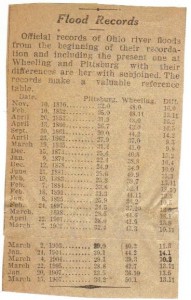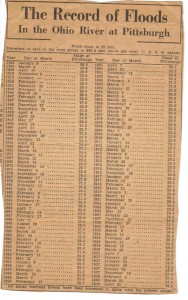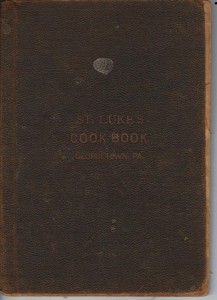The Wheeling Bridge Case in the US Supreme Court in 1849-52 and 1854-56 was interesting for its relationship between two rival cities and two competing industrial transportation systems. Wheeling wanted a bridge over the Ohio River to connect with central Ohio and Indiana. Pittsburgh wanted free navigation of the Ohio River. A Wheeling plan to secure US Congressional aid to build a simple span across the river was defeated because the elevation of 90 feet above low water would inhibit the passage of steamboats with tall smoke stacks. Even the Supreme Court decided against Wheeling. Not accepting failure, Wheeling approached the Virginia legislature where the Pittsburgh opposition could not be heard. In 1846, the Commonwealth of Virginia granted the charter to the Bridge Company. Also in 1846, Wheeling secured a promise from the Baltimore and Ohio RR of a western RR terminal. [1]
Fearing that Wheeling would become the transportation “Gateway to the West”, PA filed suit stating the bridge obstructed passage of steamboats and threatened to injure business in Pittsburgh. Edwin Stanton, a Pittsburgh attorney and later Sec of War in the Lincoln administration, argued the case for PA before the Supreme Court. Of the nine regular packets of the Pittsburgh and Cincinnati Line, five would be unable to pass under the bridge. These boats conveyed half the goods (in value) and three- fourths of the passengers between Pittsburgh and Cincinnati. VA argued that the bridge was necessary to carry freight and passengers into the interior which would be diverted from the steamboats because of the greater safety and speed of the railroads which would soon be concentrated at Wheeling. The bridge had first been proposed to carry the National Pike across the Ohio. Despite an injunction the bridge was built.[2]
Although unstated directly, this national controversy was also a skirmish between free and slave states. It was a national event drawing the attention of Henry Clay who formulated the Missouri Compromise of 1850. The South, specifically Virginia, wanted to divert commerce from Philadelphia to Norfolk. From there via Richmond to Wheeling, Virginia and slave holding influence in the Midwest and territories further west would be greatly enhanced.
Engineer Charles Ellet, Jr finished his bridge in 1849. On 15 Sep 1849, famed statesman Henry Clay was a speaker for the dedication ceremonies. He stated that “They might as well try to take down the rainbow.” Clay’s “They” were Yankees, Stanton and the Pittsburgh objectors, who feared the bridge would choke river traffic.
The steamer Hibernia No2 on 11 Nov 1849 was delayed thirty-two hours after its stacks were damaged in a collision with the structure. Its stacks stood 80 feet above the water; the bridge stood only 48 feet above water level. Another boat was hired to transport the passengers of the Hibernia No2 to Pittsburgh. Other boats were detained and at least two more accidents occurred. The Hibernia No2 was mentioned specifically because Capt George W Ebert of Georgetown, PA had an interest in the packet. Whether the Hibernia No2 intentionally rammed the bridge is still a great controversy. [3]

The Virginia passing under the Wabash Bridge note the stacks (From the Public Library of Cincinnati and Hamilton County.
In Aug 1851, a bill passed both the US Senate and House legalizing the existing conditions of the bridge and at the same time requiring steamers to regulate their chimneys so as not to interfere with the elevation and constructions of bridges. Wheeling won. Steamboats had to tailor their stacks. Pittsburgh retaliated by declaring Wheeling outside of its travel line. Pittsburgh established a station below Wheeling to induce passengers to continue to Pittsburgh. Pittsburgh also influenced the railway between Cleveland and the Ohio River to be terminated at Wellsville, OH which was located closer to Pittsburgh than Wheeling, VA. [4]
The Wheeling bridge was blown down by a gale force wind on 18 May 1854. Shortly thereafter in a derisive salute, the Pittsburgh and Cincinnati Line packet, Pennsylvania, lowered her stacks approaching Wheeling with no bridge to lower them for. Offended, a mob gathered on shore and pelted the packet with stones. [5]
Finally, the great rivalry for the title “Gateway to the West” was settled. Pittsburgh emerged as its keeper.
References.
[1] Ohio Archaeological and Historical Quarterly, Volume 22, the Ohio Historical Society, Columbus, Ohio, April 1913, p 44.
[2] Ohio Archaeological and Historical Quarterly, Volume 22, the Ohio Historical Society, Columbus, Ohio, April 1913, p 45.
[3] Ohio Archaeological and Historical Quarterly, Volume 22, the Ohio Historical Society, Columbus, Ohio, April 1913, p 46.
[4] Ohio Archaeological and Historical Quarterly, Volume 22, the Ohio Historical Society, Columbus, Ohio, April 1913, p 51.
[5] Ohio Archaeological and Historical Quarterly, Volume 22, the Ohio Historical Society, Columbus, Ohio, April 1913, p 52
Copyright © 2015 Francis W Nash All Rights Reserved
No part of this website may be reproduced without permission in writing from the author.




